2011年第十三届中国科协年会-中国药理学会
- 格式:doc
- 大小:51.50 KB
- 文档页数:3

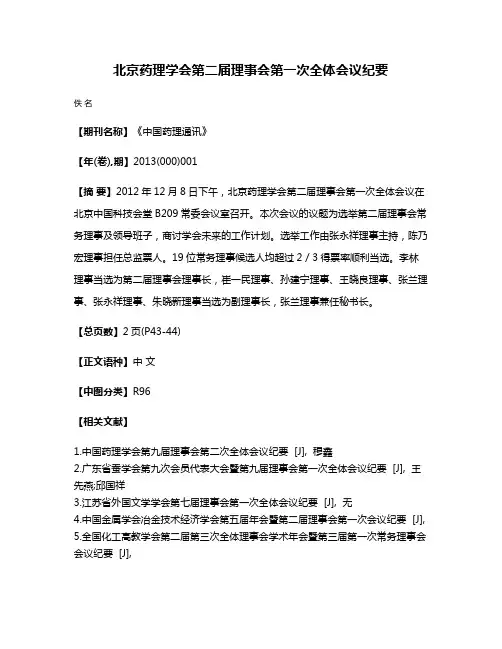
北京药理学会第二届理事会第一次全体会议纪要
佚名
【期刊名称】《中国药理通讯》
【年(卷),期】2013(000)001
【摘要】2012年12月8日下午,北京药理学会第二届理事会第一次全体会议在北京中国科技会堂B209常委会议室召开。
本次会议的议题为选举第二届理事会常务理事及领导班子,商讨学会未来的工作计划。
选举工作由张永祥理事主持,陈乃宏理事担任总监票人。
19位常务理事候选人均超过2/3得票率顺利当选。
李林
理事当选为第二届理事会理事长,崔一民理事、孙建宁理事、王晓良理事、张兰理事、张永祥理事、朱晓新理事当选为副理事长,张兰理事兼任秘书长。
【总页数】2页(P43-44)
【正文语种】中文
【中图分类】R96
【相关文献】
1.中国药理学会第九届理事会第二次全体会议纪要 [J], 穆鑫
2.广东省蚕学会第九次会员代表大会暨第九届理事会第一次全体会议纪要 [J], 王先燕;邱国祥
3.江苏省外国文学学会第七届理事会第一次全体会议纪要 [J], 无
4.中国金属学会冶金技术经济学会第五届年会暨第二届理事会第一次会议纪要 [J],
5.全国化工高教学会第二届第三次全体理事会学术年会暨第三届第一次常务理事会会议纪要 [J],
因版权原因,仅展示原文概要,查看原文内容请购买。

中国药理学会第六届会员代表大会新一届理事会成立
佚名
【期刊名称】《四川生理科学杂志》
【年(卷),期】1993(000)0Z1
【摘要】中国药理学会第六届会员代表大会经过一年多的筹备工作,已于本年5月15—18日在北京召开。
我会代表来自全国各省市共约四百余人。
经过各省市蕴酿提名,在本届代表会上无记名选举产生了第六届理事会。
我省会员当选为理事的有王浴生、包定元、胡友梅,薛春生、王一涛、黄衡同志。
王浴生与包定元教授还当选为常务理事。
【总页数】1页(P35-35)
【正文语种】中文
【中图分类】R33
【相关文献】
1.中国畜牧兽医学会期刊编辑学分会召开第六届会员代表大会《中国乳业》杂志社社长冯艳秋当选为新一届理事会理事长 [J], 聂迎利
2.中设协新一届理事会诞生中国勘察设计协会第六届会员代表大会暨六届一次理事会议在京召开 [J],
3.贯彻落实科学发展观,积极推进保险理论研究,深入开展保险知识宣传上海市保险学会积极为上海保险市场又好又快发展作贡献——上海市保险学会召开第七届会员大会,选举产生新一届理事会,孙国栋当选名誉会长,张俊才任新一届理事会会长,潘涨潮任理事会秘书处秘书长 [J], 梁慧萱
4.中国电子商会第六届会员代表大会暨全体理事会在京召开王宁先生高票当选中国
电子商会新一届会长 [J], 黄雪怡;赵江涛
5.云南省水力发电工程学会第六次代表大会选举学会新一届理事会和学会六届一次理事会选举新一届常务理事会和学会领导人选举结果 [J],
因版权原因,仅展示原文概要,查看原文内容请购买。
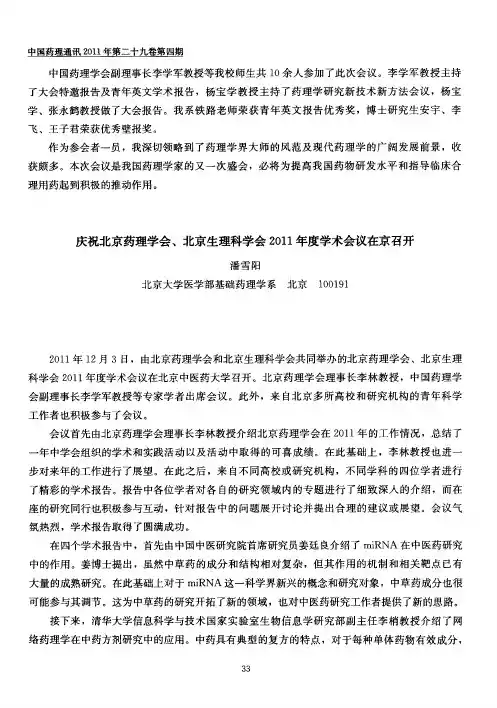
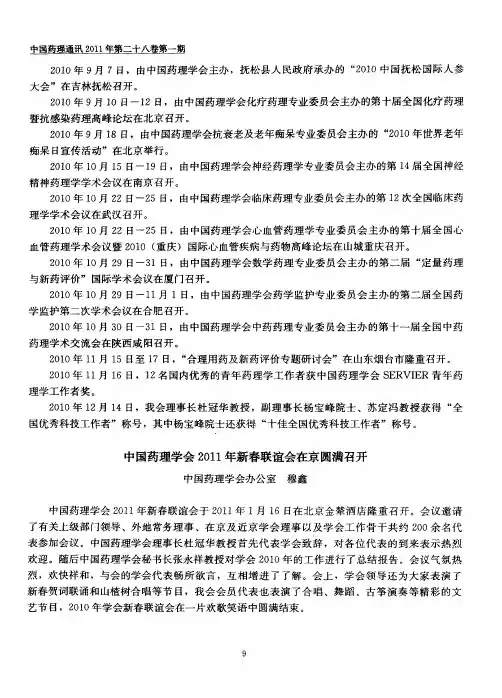
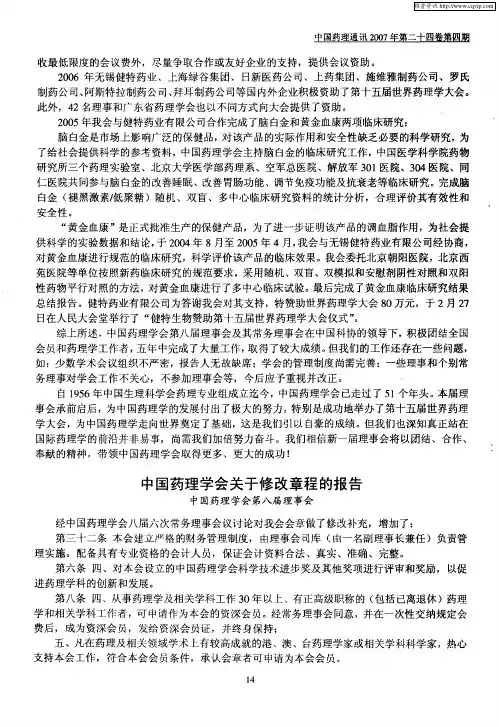
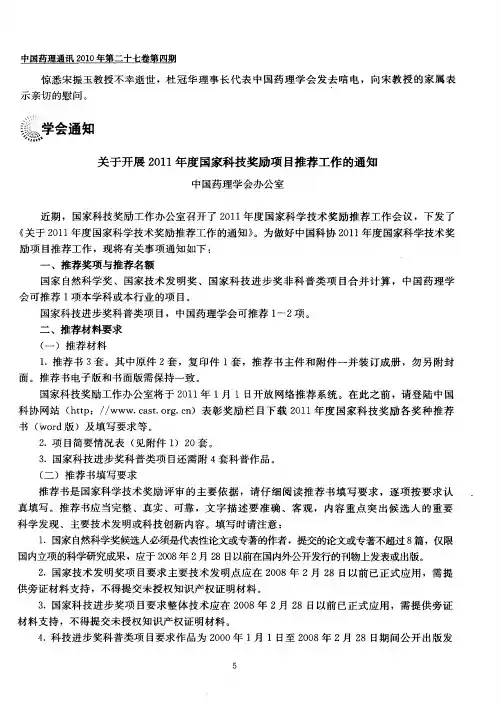
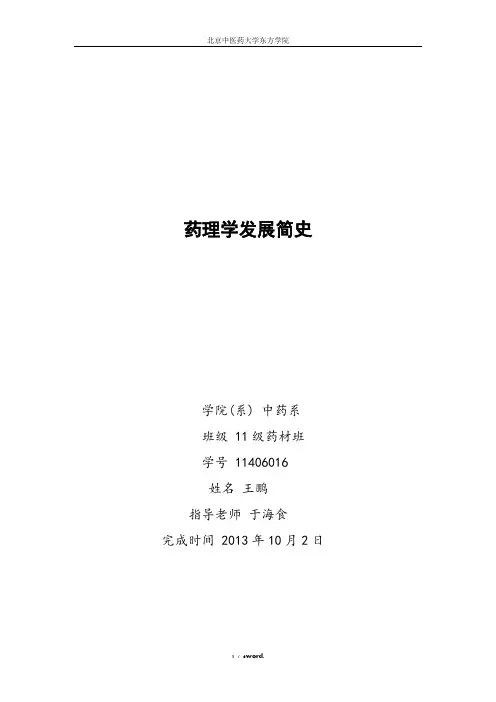
药理学发展简史学院(系) 中药系班级 11级药材班学号 11406016姓名王鹏指导老师于海食完成时间 2013年10月2日摘要:药理学(pharmacology)是研究药物和机体相互作用及其规律的一门学科。
其内容包括药物药物效应动力学(pharmacodynamics)和药物代谢动力学(pharmacokinetics)。
这门学科经历了药物学阶段和现代药理学阶段,两个阶段的发展和完善才形成一门现代科学。
而中国在药理学的发展付出巨大的贡献,本文将重点论述中国在世界药理学发展历史所起到的作用和中国药理学的发展过程。
关键词:药理学发展历史药物学现代药理学中国前言药理学一直伴随着人类历史的发展而发展,数学、物理学、化学和生物学等基础科学是药理学发展的支柱,相关历史事件众多。
已有文献根据认识规律对药理学的发展进行过简要阐释,但未提出合理的发展阶段。
现行的药理学教科书中在绪论中对药理学的发展进行了简要介绍,但多以时间为线索罗列药理学甚至生物医学的主要历史事件,未能对这些历史事件进行有线索地归纳,也未提出合理的发展阶段,甚至将药理学事件和基础科学发展事件不加区分地列在一起。
因此,笔者将药理学发展归为两个阶段,药物学阶段和现代药理学阶段。
药理学发展简史药理学是研究药物和机体相互作用的一门科学。
[1]它阐明了药物防治疾病的基本规律性,从而为临床合理用药提供基本理论。
其中本学科的发展分为药物学阶段和现代药理学阶段两个阶段,中国在这两个阶段的发展中都付出了巨大贡献。
一.最初发展阶段:药物学众所周知,药理学是基于古代的药物学或者称本草学的基础上发展开来的[2]。
最早的药理学源于对“火”与“酒”的认识和利用。
古代,原始人的生活环境十分差。
为了生存必须猎取食物,当时主要食物来源是渔猎动物和采摘植物。
最初并不知道哪些可食哪些有毒,难免遇到致吐、腹泻、发汗、止痛、止血等情况,甚至也会有中毒死亡的情况发生。
在此阶段,古人们主要采用试错法来进行药物防病治病的探索。
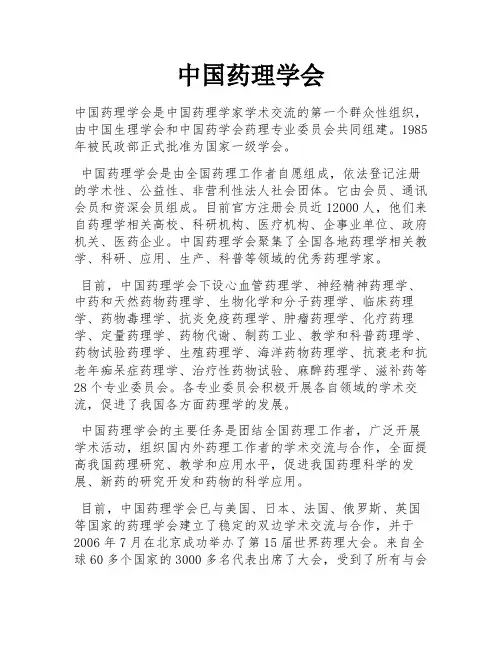
中国药理学会中国药理学会是中国药理学家学术交流的第一个群众性组织,由中国生理学会和中国药学会药理专业委员会共同组建。
1985年被民政部正式批准为国家一级学会。
中国药理学会是由全国药理工作者自愿组成,依法登记注册的学术性、公益性、非营利性法人社会团体。
它由会员、通讯会员和资深会员组成。
目前官方注册会员近12000人,他们来自药理学相关高校、科研机构、医疗机构、企事业单位、政府机关、医药企业。
中国药理学会聚集了全国各地药理学相关教学、科研、应用、生产、科普等领域的优秀药理学家。
目前,中国药理学会下设心血管药理学、神经精神药理学、中药和天然药物药理学、生物化学和分子药理学、临床药理学、药物毒理学、抗炎免疫药理学、肿瘤药理学、化疗药理学、定量药理学、药物代谢、制药工业、教学和科普药理学、药物试验药理学、生殖药理学、海洋药物药理学、抗衰老和抗老年痴呆症药理学、治疗性药物试验、麻醉药理学、滋补药等28个专业委员会。
各专业委员会积极开展各自领域的学术交流,促进了我国各方面药理学的发展。
中国药理学会的主要任务是团结全国药理工作者,广泛开展学术活动,组织国内外药理工作者的学术交流与合作,全面提高我国药理研究、教学和应用水平,促进我国药理科学的发展、新药的研究开发和药物的科学应用。
目前,中国药理学会已与美国、日本、法国、俄罗斯、英国等国家的药理学会建立了稳定的双边学术交流与合作,并于2006年7月在北京成功举办了第15届世界药理大会。
来自全球60多个国家的3000多名代表出席了大会,受到了所有与会药理学家的一致好评,被国际药理学家联合会官员誉为世界药理学发展史上的里程碑。
中国药理学会主办有《中国药理学报》(英文版)、《中国药理学通报》、《中国药理学与毒理学杂志》、《中药药理与临床》、《中国临床药理学与治疗学杂志》、《医药导报》和《神经药理学报》等学术期刊,在国内外学术交流中发挥了积极的作用。
中国药理学会的内部刊物《中国药理通讯》也为会员信息交流提供了平台。
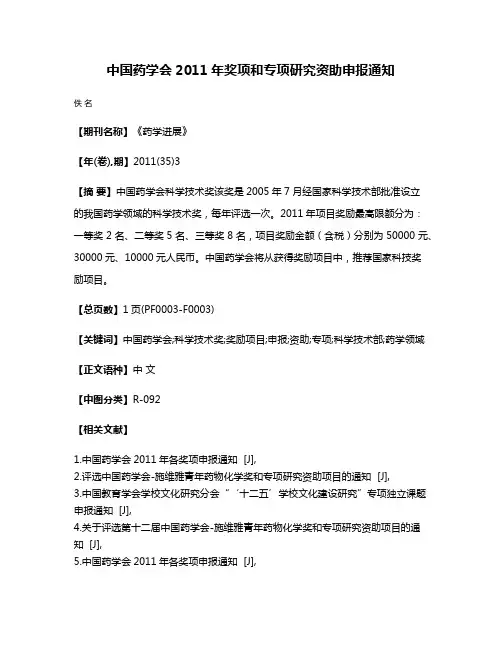
中国药学会2011年奖项和专项研究资助申报通知
佚名
【期刊名称】《药学进展》
【年(卷),期】2011(35)3
【摘要】中国药学会科学技术奖该奖是2005年7月经国家科学技术部批准设立
的我国药学领域的科学技术奖,每年评选一次。
2011年项目奖励最高限额分为:一等奖2名、二等奖5名、三等奖8名,项目奖励金额(含税)分别为50000元、30000元、10000元人民币。
中国药学会将从获得奖励项目中,推荐国家科技奖
励项目。
【总页数】1页(PF0003-F0003)
【关键词】中国药学会;科学技术奖;奖励项目;申报;资助;专项;科学技术部;药学领域【正文语种】中文
【中图分类】R-092
【相关文献】
1.中国药学会2011年各奖项申报通知 [J],
2.评选中国药学会-施维雅青年药物化学奖和专项研究资助项目的通知 [J],
3.中国教育学会学校文化研究分会“‘十二五’学校文化建设研究”专项独立课题申报通知 [J],
4.关于评选第十二届中国药学会-施维雅青年药物化学奖和专项研究资助项目的通
知 [J],
5.中国药学会2011年各奖项申报通知 [J],
因版权原因,仅展示原文概要,查看原文内容请购买。
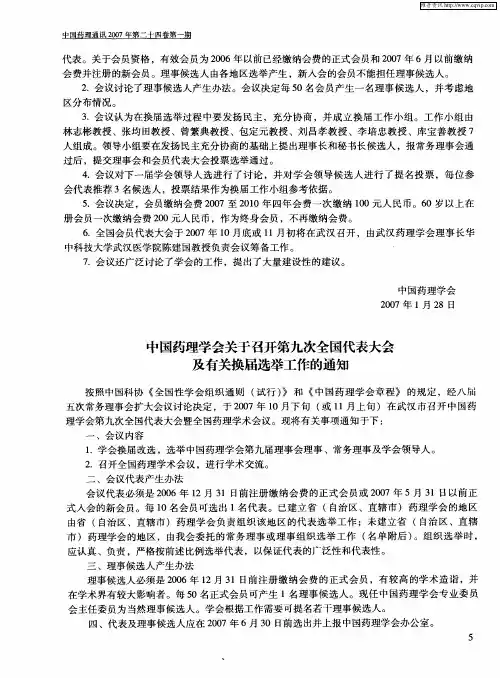
中国科学技术协会关于聘任第一批首席科学传播专家的通知文章属性•【制定机关】中国科学技术协会•【公布日期】2013.12.24•【文号】科协发普字[2013]75号•【施行日期】2013.12.24•【效力等级】团体规定•【时效性】现行有效•【主题分类】基础研究与科研基地正文中国科学技术协会关于聘任第一批首席科学传播专家的通知(科协发普字〔2013〕75号)各全国学会、协会、研究会,各省、自治区、直辖市科协,新疆生产建设兵团科协:为全面贯彻落实党的十八大和全国科技创新大会精神,根据《全民科学素质行动计划纲要实施方案(2011-2015年)》和《中国科协科普人才发展规划纲要(2010-2020年)》的部署,为加强科普人才队伍建设,提升科普公共服务能力,促进公民科学素质建设目标的实现,2013年,中国科协启动组建科学传播专家团队。
按照《中国科协办公厅关于组建科学传播专家团队的通知》(科协办发普字〔2013〕40号),各全国学会认真组织推荐,经研究审查,决定聘任朱邦芬等156名专家为第一批全国首席科学传播专家,聘期3年。
首席科学传播专家开展公益性科普活动时,可以“**学科首席科学传播专家”名义进行宣传和介绍。
各全国学会、各级科协组织要为科学传播专家搭好台、服好务,紧紧依托首席科学传播专家及科学传播专家团队,大力推进科学传播工作,不断提升学科科普服务水平和社会影响力。
希望首席科学传播专家及团队珍惜荣誉、承担责任,带领科学传播专家团队,按照《全民科学素质行动计划纲要实施方案(2011-2015年)》的总体部署,围绕党和国家经济社会发展中心任务和人民群众生产生活实际需求,大力开展科普创作、科学传播,推动拓展学科科普工作,团结引领广大科技工作者,积极投身公民科学素质建设,为实施创新驱动发展战略、全面建成小康社会、实现两个百年奋斗目标、实现中华民族伟大复兴的中国梦做出新的更大贡献!附件:第一批全国首席科学传播专家名单中国科协2013年12月24日附件第一批全国首席科学传播专家名单(共156人分学会按姓氏笔画为序)中国系统工程学会:中国腐蚀与防护学会:中国造纸学会:中国毒理学会:。
ORIGINALSeparation of Natural Food Pigments in Saponified and Un-Saponified Paprika Oleoresin by Ultra HighPerformance Supercritical Fluid Chromatography (UHPSFC)Terry A.Berger •Blair K.BergerReceived:21March 2013/Accepted:4April 2013ÓSpringer-Verlag Berlin Heidelberg 2013Abstract The natural pigments in paprika were rapidly and efficiently separated by ultra high performance super-critical fluid chromatography.The separation of both un-saponified and saponified mixtures of paprika oleoresin were optimized,with run times of 10.6min.Three differ-ent C18columns,a cyano,silica and diol column,all 39100mm,with 1.8l m particles were compared.The best separation for the un-saponified sample was found with an SB-C18column,while the saponified samples were best separated on a bare silica,RX-Sil column.A SB-CN column allowed near optimum separation of both the un-saponified,and saponified samples,with similar run times.The best mobile phase was carbon dioxide (CO 2)modified with isopropyl alcohol (IPA),with a composition gradient.Fingerprints of several commercial pepper products indi-cated that one appeared to be colored with artificial dyes,while the color of a chili powder may have been enhanced with a paprika extract.Spectra,using CO 2with IPA as modifier,produced a single maximum at 453nm,which appears to represent up to a 30nm solvatochromic shift from the maxima in most organic solvents.Acetonitrile (ACN)as modifier produced spectra with two maxima and a similar solvatochromic shift.These results appear to be the first on saponified paprika oleoresin samples using SFC.It is also the first detailed report on the separation of un-saponified samples.The results are up to six times faster than comparable results by HPLC.It appears that SFC is a viable,superior alternative to HPLC for the analysis of this important commercial product,without using ACN,or chlorinated solvents.Keywords Ultra high performance supercritical fluid chromatography (UHPSFC)ÁSub-2l m particles ÁSolvatochromic shift ÁPaprika oleoresin ÁCapsanthin ÁNatural food dyesIntroductionThere is a genuine public concern over the use of artificial dyes in foods and beverages,which has led to the wide-spread switch to pigments from natural products and foods.Peppers contain carotenoids which are some of the most intensely colored pigments in nature.Paprika (Capsicum annuum L.)has been used for centuries to color foods,and for decades for the commercial extraction of large amounts of red pigments to be used in processed foods.Up until a decade ago,virtually all such extractions were performed using relatively non-polar organic solvents,such as hexane,acetone,or dichloromethane.The use of such solvents created an additional problem in the form of solvent resi-dues in the extract,which are strictly controlled.Many of the techniques used to remove the solvents damaged the color and degraded the product.Fortunately,starting a little over a decade ago,there was a major shift away from toxic and expensive organic solvents,toward the use of super-critical fluid extraction (SFE)using carbon dioxide (CO 2)as the extracting fluid [1–3].At the end of the extraction,the CO 2simply evaporates,leaving no toxic residues.After the extraction solvents are removed,a viscous,intensely red liquid or paste is left behind called paprika oleoresin.The majority of the color is due to two com-pounds:capsanthin and capsorubin,although a number of other colored components are present.The quality and value of paprika and paprika oleoresin depends on the intensity of the color,but also on other qualities.InT.A.Berger (&)ÁB.K.BergerSFC Solutions,Inc.,9435Downing St.,Englewood,FL 34224,USA e-mail:tabergersfc@ChromatographiaDOI 10.1007/s10337-013-2466-yaddition to the most desired colored pigments,significant amounts of b -carotene,and c -tocopherol,both anti-oxi-dants,are present,which tend to protect the pigments within the plant material,and are usually extracted with the pigments.Further,provitamin A is present in very high concentrations,compared to other natural sources.The presence of these compounds tends to increase the value of the product.Extraction changes the interactions between the desired compounds,and the other compounds that tend to protect them from degradation within the fruit.Proper storage becomes an issue.Both capsanthin and capsorubin contain two hydroxyl groups,one on each of the rings at the two ends of a long terpenoid central chain,as shown in Fig.1.As the fruits ripen,these hydroxyl groups form mono and di-esters with fatty acids,although some remain free.Capsanthin is present in the fruit both in its free form,and as mono-,and di-esters.Capsorubin is mainly present in ripe fruit as diesters [4,5].In one study [4],only 5.7%of all the capsanthin present was free,with 4mono-esters totaling 33.8%,and 5dies-ters totaling 60.5%.Free capsorubin represented only 6.7%of the total,while 10.2%was present as a mono-ester,and 83.1%was present as a di-ester.Capsanthin and its esters made up 78.0%of all the areas found at high wavelengths.Capsorubin,and its esters,only 2.8%.In the other study [5],44carotenoids were found.Only 6.8%of capsanthin was free with 4mono-esters and 5di-esters.After saponification,60±3%of the total area was capsanthin and 7.7%was capsorubin.Due to their non-polar nature,the esters are concentrated in fatty globules which appear to stabilize the pigments.Formation of these esters has no impact on the color of the pigments,but results in multiple chromatographic peaks for each compound.High performance liquid chromatography (HPLC)has been the technique of choice [2,3,5–11]for determining the quality of paprika oleoresins.Many approaches use acetonitrile and/or dichloromethane as part of the mobile phase.It seems ironic,and a bit archaic,that extraction with organic solvents has been replaced with a much less toxic,greener alternative SFE,only to use those same toxic,polluting solvents to analyze the extracts by HPLC.With the raw extracts,chromatograms can be quite complex,sometimes with [70partially resolved maxima,with run times exceeding 75min.In order to simplify the chromatogram,and clarify the distribution of the key components,the oleoresins are sometimes saponified [11,12]to convert all the esters of the same compound,into the single free form.Saponification was shown to dramatically decrease sample complexity,and could produce HPLC run times below 20min.However,there are many warnings about sample degradation accompanying saponification.Supercritical fluid chromatography (SFC)is generally considered to be a replacement technology for HPLC,since it is considered to be three to five times faster,less expen-sive to operate,and is greener.There appear to be only two rather obscure references to the separation of paprika oleoresin by SFC;an application note by Hewlett Packard in 1983[13]and a single chromatogram in a paper dealing with coupled SFE/SFC [14],using similar conditions,with similar results.In neither case were the samples saponified.A number of broad,distorted peaks were poorly resolved in 16–26min,although a relatively smaller number (6–10)of major components appeared to be present.The purpose of the present work is to determine if SFC could replace non-aqueous reversed phase HPLC for the analysis of either un-saponified or saponified paprika ole-oresins,and eliminate the use of chlorinated solvents,or acetonitrile.This would require a substantial improvement in peak shapes,and resolution compared to the sparse previous work.Further,it was of interest to use columns with sub-2l m particles,to try to rapidly resolve such a complex natural productmatrix.Fig.1Structures of the two most common components in paprika oleoresin.Thesecompounds are most commonly present as mono-and di-esters with fatty acids substituted onto the –OH groups on the end ringsT.A.Berger,B.K.BergerExperimentalInstrumentationAn Agilent Technologies Model1260Hybrid HPLC/SFC system(Waldbronn,Germany)was used as the chromato-graph,but used exclusively here in the SFC mode.The system includes an SFC conversion module that expands the use of the HPLC into an ultra high performance SFC (UHPSFC).The system has an upper pressure capability of 600bar.The instrumentation was previously shown to have extremely low extra-column dispersion[15],and can truly be classified as an UHPSFC.System control was through‘‘modern’’ChemStation.The SFC conversion module contains a powerful con-denser that allows the use of the vapor phase of CO2.Low cost industrial or beverage grade CO2can be used since non-volatile contaminants remain in the pared to organic solvents,this CO2is extremely inexpensive.The Model1315C diode array detector(DAD)was capable of collecting80Hz data,and was used with a 3mm,2l L low dispersionflow cell.All the chromato-grams were collected with spectra.The slit was set to1nm. The bandwidth of each of the signals was set to2nm. Detection was at220,425,440,and470nm,without a reference.The mobile phase was preheated in the right hand heat exchanger of the thermal control compartment(TCC) before entering the column.The left hand heat exchanger (LHX)was used to control the temperature of the mobile phase to the temperature of theflow cell to avoid issues with changes in refractive index.A hand held meter with a thermocouple was used to monitor the cell temperature, and the LHX temperature was changed manually,although the DAD was set to control its internal temperature,and the actual cell temperature changed only very slightly.MaterialsThree different C18columns:SB-C18,Eclipse Plus-C18,and Eclipse XDB-C18,plus an SB-CN column,and an RX-Sil column,all39100,1.8l,all from Agilent Technologies, were evaluated.In addition,an Epic Diol HILIC column from ES Industries,West Berlin,New Jersey,with the same 39100mm,1.8l m format was evaluated.Acetonitrile(ACN),acetone,heptane,isopropyl alcohol (IPA),ethyl acetate(EtAc),methanol,and water,all Om-nisolve HPLC grade,were purchased from SECO,Aston, PA.Potassium hydroxide(KOH)pellets were obtained from EMD,Gibbstown,NJ,USA.Methanolic KOH(5%) was prepared by dissolving5g KOH in100mL methanol. Carbon dioxide was beverage grade,obtained from Terry Supply Co.,Sarasota,FL,USA.A sample labeled‘‘Capsanthin(paprika extract,vege-table oil solution)’’was purchased from TCI Americas, Portland OR,USA.A store brand,and a name brand paprika,a chili powder,and an Italian ground pepper product were purchased at local markets.The store brand paprika,the chili powder,and the Italian pepper,all listed silicon dioxide as an ingredient on their labels,one said to ‘‘aidflow’’.Preparing Paprika OleoresinsAn SFE instrument was not available.Consequently, extraction with an organic solvent was resorted to.The paprika samples,chili power sample,and the red Italian pepper product,were each extracted,with heptane:acetone. In addition,one of the paprika’s was also extracted with acetone,only.Two grams of each sample were placed in a20mL scintillation vial and10mL of acetone:heptane(50:50v/v) was added.The samples were sonicated for6min,then let stand for10min to settle particulates.The liquid was decanted off and an additional5mL of acetone:heptane was added,sonicated,and decanted with the same times. Most of the red coloration was removed but there was no attempt to be quantitative,or extract exhaustively,since this is a feasibility study about the chromatographic sepa-ration of the compounds present.The extracts from each sample were combined,and centrifuged at3,400rpm for10min to settle particulates. Care was taken to minimize exposure to light.Pooled extracts were dried down on large watch glasses,at room temperature with high airflow,until no noticeable change in volume occurred.All the samples produced very vis-cous,deep red liquids.These liquids were dissolved in ethyl acetate,transferred to amber2mL autosampler vials and analyzed as is.Some of the samples were also sub-jected to several methods of saponification.Sample SaponificationThe raw extracts contain the free forms,plus mono-,and di-esters of the colored components.In order to simplify the chromatograms,the esters were saponified to convert them to the free form.There are a number of different saponifi-cation procedures in the literature,using5–60%metha-nolic KOH.However,there are also many warnings about the instability of many of the compounds when excessive heat is used.Thus,there is a dichotomy between adequate saponification,and destruction of part of the sample.Thefirst method evaluated[2],consisting of overnight saponification with5%methanolic KOH,at room tem-perature,was dramatically unsuccessful.Separation of Natural Food Pigments in Paprika OleoresinIn an intermediate approach,a1g capsanthin sample in vegetable oil,was diluted with3mL heptane,then3mL 5%KOH in methanol,was added.The mixture was heated in a water bath at65°C with stirring for20min[11,12]. The samples were in a20mL scintillation vial,with a tightly closed screw cap.After cooling,3mL water was added to remove KOH.Three millilitre of ethyl acetate were added along with enough salt(NaCl)to insure the lower phase was saturated.This produce an intensely col-ored upper organic phase of mostly heptane/ethyl acetate, and a pale yellow but clear lower,mostly aqueous/metha-nol,phase.Unfortunately small amounts of many unsapo-nified components remained in subsequent chromatograms.Thefinal approach tried,involved the same initial steps but increased the heating to reflux the solvent at80–85°, inside the sealed vial,for a minimum of30min.After cooling,and the addition of water,salt,and ethyl acetate, the sample slowly separated into two phases.Small vari-ations in the volumes of the various solvents produced poorer results,sometimes with three phases with color distributed between two of the three phases.The upper, intensely colored phase was removed,and rewashed with an additional3ml of water,plus salt,then,part was transferred to a2mL amber autosampler vial for analysis. Such samples yielded the simplest chromatograms,but there were still a number of trace components,which might represent unsaponified esters.The salt had a major impact on the nature of the phases. Without the salt,an emulsion often formed on stirring,and the lower,mostly aqueous phase often had a much deeper orange color.The addition of salt broke the emulsion, created two distinct phases,and caused additional orange colored components to partition into the mixed organic phase.The acetone extract of paprika produced a three phase system when the water was added.Upper and lower phases contained little color,but spherical globules of intense red color were lying on the meniscus between the two main phases.With the addition of ethyl acetate and salt,the third phase disappeared and the red color partitioned into the upper organic phase.Results and DiscussionChromatographic ApproachIn an early1980s application note,Gere[13]used1% ethanol premixed into CO2,and a4.69150mm,column packed with3l m Hypersil ODS to partially separate a paprika oleoresin.It was then felt that the long terpenoid chains of the various pigments would likely interact well with a long hydrocarbon chain of a non-polar phase,such as C18.The use of3l m particles was relatively new at the time.Gere also used very low concentrations of modifier.He dispensed specific volumes of modifier into a small(sev-eral liter)high pressure cylinder,which was then sealed, and CO2was added up to a desired weight.Thefluid was subsequently pumped as a singlefluid,precluding the use of composition gradients.It is now known that such an approach results in a continual change in modifier con-centration,since,in the cylinder,the vapor phase and liquid phase have different compositions[16].A further compli-cation arises,since it is not recommended to pump at compositions significantly below5%modifier,since doing so tends to createflow and composition noise,due to the very low frequency of the modifier pump.Column and instrument technology have changed dra-matically since the1980s.There is now a much greater emphasis on the use of even smaller sub-2l m particles, and a number of variations of silica supports are now available.For example,Agilent manufactures three dif-ferent kinds of C18stationary phases,on different silicas, each in1.8l m totally porous particles.To achieve a weaker mobile phase,it is now preferable to use a somewhat higher concentration of a weaker sol-vent,or even use a mixed modifier,such as10%IPA dissolved in heptane.For this work,it was decided to ini-tially use the less polar isopropyl alcohol as modifier, instead of the ethanol used by Gere.On Snyders P’solvent strength scale[17,18],ethanol is4.3while IPA is3.9(on a scale of0to&10).Several other modifiers were also evaluated.Un-Saponified Capsanthin in Vegetable OilAn un-saponified commercial sample,labeled‘‘capsanthin, paprika extract in vegetable oil’’,was used through-out method development.After a number of false starts,a gradient elution method was developed that could be used on all the columns tried.The results on an SB-C18,Eclipse Plus-C18,and an Eclipse XDB-C18column are presented in Fig.2.It was found that the use of very low modifier concentrations was not necessary,since the vast majority of sample components were significantly retained at5%IPA. In fact,a composition gradient to higher concentrations was desirable to shorten run times.The IPA concentration was held constant at5%for 0.6min,then increased to20%at6.6min,then held at 20%until10.6min.Flow rate was1.95mL min-1.The column pre-heater temperature and column outlet pressure were50°C and150bar respectively.The DAD was con-figured to continuously collect spectra with a slit width of 1nm,and afilter setting of[0.03min.Most of theT.A.Berger,B.K.Bergerchromatograms shown were collected at440nm with a 2nm bandwidth.The three1.8l m C18columns all produced similar,but not identical chromatograms,with many incompletely resolved maxima,with three larger peaks near the end of the chromatograms.All showed substantial improvements in resolution and peak shapes compared to earlier reports [13,14].Thirty or more maxima were observed.Retention decreased in the order:SB-C18,Eclipse Plus-C18,and Eclipse XDB-C18.All three columns produced signifi-cantly higher resolution in shorter times compared to the 3l m ODS column used by Gere.The chromatograms were fast,despite the complexity of the sample,due largely to the use of sub2l m particles. The column hold-up time was less than0.3min.Pressure drops were modest at200bar or less.All the components appear to have eluted from each of the three columns in less than8min.However,the patterns of small peaks between2–3and3–5min(Fig.2),differed significantly between the columns,and the signals seldom returned to the baseline,between major maxima.The pattern of the three larger peaks,near the end of the chromatograms closely resembled a pattern in chromato-grams in a reversed phase HPLC report[9],also collected on C18columns,but using mixtures of acetone,methanol and water as mobile phases,which required[70min run time.A shallower gradient,over a longer period,was used to attempt to near baseline resolve as many of the components as possible.This gradient consisted of an initial hold at5% for2min,followed by a gradient to12.5%IPA,at 22min,then hold to25min.The other conditions were the same: 1.95mL min-1,50°C,and150bar.Resolution improved somewhat,and at least ten more maxima could be discerned in the resulting chromatograms,as shown in Fig.3.The signals returned to near the baseline between the major peaks.Unfortunately,capsanthin,and capsorubin and their fatty acid mono-and di-esters have nearly iden-tical spectra[4].Without a mass spectrometer or NMR analysis or saponification they cannot be differentiated.Alternate ModifiersIt was of interest to determine if a change of modifier might change,or improve,resolution and selectivity.The SB-C18Separation of Natural Food Pigments in Paprika Oleoresinwas used as representative of C18columns and the IPA was replaced with ACN,EtAc,and acetone.The results, shown in Fig.4,indicate only subtle differences in selec-tivity,compared to IPA.Each is classified as a type VI solvent,whereas IPA is a type II solvent[17,18].More Polar ColumnsMore polar stationary phases were also evaluated to see if selectivity could be changed.The results from an SB-CN,a RX-Sil,and an Epic Diol HILIC column,each 39100mm,packed with1.8l m particles,were com-pared to the SB-C18column result,as shown in Fig.5.The same5–20%gradient,over10.6min,was used with IPA as modifier.Dramatic changes in selectivity were evident.The low polarity solutes,present in the un-saponified sam-ple,showed significantly less retention on all the more polar columns,compared to the SB-C18column.Both the RX-Sil and Epic Diol HILIC exhibited very little retention for the vast majority of the area under the peaks,although both indicated the presence of a large number of minor components.The SB-CN column,on the other hand,produced an intermediate chromatogram with the same time frame as the Eclipse XDB-C18column,but with a very different selectivity from any of the C18columns.The SB-CN column was further evaluated for the separation of the un-saponified sample by using several alternate modifiers: ACN,MeOH and EtAc.This time ACN and EtAc showed significantly different selectivity compared to the alcohols, as shown in Fig.6.Both resolved what appear to be clus-ters of related groups of small peaks that eluted both before and after the main components.It would be very interesting to speciate these peaks with an appropriate mass spec-trometer.A substantially higher concentration of ethyl acetate was required(30%)to remove the late eluters. Methanol was the strongest modifier and generated the least retention using the standard gradient.The SFC results,using unsaponified paprika oleoresin exhibit higher resolution in much shorter times compared to HPLC,while potentially avoiding the use of chlorinated solvents,or acetonitrile.Such results,combined with an appropriate mass spectrometer should allow speciation, without saponification.T.A.Berger,B.K.BergerSaponified Capsanthin in Vegetable OilSaponification is intended to simplify the chromatograms and make it easier to determine the commercial value ofthe product,at least by quantifying the capsanthin and capsorubin present.However,cleaving the esters,can result in sample degradation,and creates somewhat more polar compounds than the esters.This change in polarity of the solutes had significant implications for the choice of stationary phase.Unlike the results with the unsaponified sample,none of the C18columns yielded acceptable chromatograms of the saponified sample,by exhibiting minimal retention,and minimal separation of the components.The SB-C18col-umn was more retentive of the saponified components, compared to the other two C18columns.The more polar SB-CN,RX-Sil,and Epic Diol HILIC columns retained the saponified sample much more strongly,with better peak shapes and resolution.This behavior is opposite to the results with the un-saponified sample.The results with the SB-C18column using the sapon-ified sample were compared to SB-CN,RX-Sil,and the Epic Diol HILIC column,as shown in Fig.7.The chro-matograms of the saponified sample are much simpler, with one main peak,as desired.The main peak was nearly baseline resolved on both the RX-Sil and Diol columns,using the standard fast gradient.On all the more polar columns,the main peak tended to front significantly. This is the only peak in the chromatogram that signifi-cantly fronts.Spectra from the leading and trailing edges were virtually identical,but the peak purity feature of the DAD and ChemStation suggests this peak was impure. Resolution of this peak was never improved under any conditions tried.Spectra were not very helpful for purity determinations,since many of the peaks exhibited virtu-ally identical spectra.There are vague hints in the liter-ature that the impurity in the peak may be capsanthin epoxide.For clarity,the chromatograms of the saponified and unsaponified samples using RX Sil are compared in Fig.8. Virtually none of the larger peaks in the chromatogram of the saponified sample are evident in the unsaponified chromatogram.This suggests the main components had been almost completely esterified in the un-saponified sample,and that the saponification was a success.However, the largest peak in the saponified sample in Fig.8only represents roughly46%of the total area at470nm,and is apparently impure.This is inconsistent with the HPLC lit-erature,which suggests capsanthin and its esters should be present at60to78%[4,5].Separation of Natural Food Pigments in Paprika OleoresinTemperature EffectsIt has sometimes been suggested that modest changes in temperature might result in changes in selectivity.Changing temperature with a shallower gradient was used to try to maximize resolution of the saponified sample.A gradient method of5%IPA for2min,then15%at22min,with a hold to25min,1.95mL min-1,150bar was used,and the temperature was varied from40to60°C.While there wereminor changes in the separations,the over-all result was not much different,as shown in Fig.9.These chromatograms were collected with an inadequately saponified sample.Most of the small peaks before12–14min are un-saponified components and can be ignored.The region of interest is both just in front,and behind the major peak.Resolution is improved due to the shallower gradient and longer retention, but temperature had only a minor effect on selectivity.The main peak continued to front.Other ModifiersMethanol and acetonitrile were compared to IPA as modi-fiers,using the RX-Sil column and the standard fast gradi-ent.The results shown in Fig.10,indicate IPA gave the best results among the modifiers tried.Methanol was too strong. ACN was surprisingly weak,yielding a severely fronting main peak,and did not elute everything,even when the concentration was held at20%for16min.This is in contrast to the result with the unsaponified(less polar?) sample,where ACN produced less retention than IPA.Real SamplesThe SB-C18column,with the fast IPA gradient,were used to make rapidfingerprints of a number of other unsaponi-fied samples.Two commercial paprikas,a chili powder, and an Italian pepper product,purchased at a local market, were extracted using acetone\heptane,as described earlier, and dried down to viscous,deep red oleoresins,which were then taken up in ethyl acetate.The oleoresins accounted for approximately10%of the original samples,by weight.All but one of the chromatograms was nearly identical to the commercial capsanthin sample,as shown in Fig.11. However,the Italian pepper product appeared to exhibit an extremely simple chromatogram,with one very large peak, with an absorbance of1,200mAU,and a smaller secondary peak of&200mAU,as seen in the bottom chromatogram of Fig.11.On a much-expanded scale,a very faint,complex chromatogram emerged,with the largest peak less than 10mAU high,as shown in the top of Fig.12.This faint chromatogram is compared to a capsanthin chromatogram (bottom,Fig.12),and indicates that the compounds presentT.A.Berger,B.K.Bergerin the two samples are substantially different,as one might expect,since the peppers are different species.The major peaks are significantly shifted in time,and there are many minor peaks past7min,which are not present in the paprikaextracts.The visual color of this sample was also different from all the other samples in that there was no hint of the orange component present in the paprika oleoresins.It was speculated that the color of this sample had been significantly enhanced using one or two artificial dyes.The chili pepper result presents another interesting sit-uation in that one would not expect the profile of a spicy chili pepper to be the same as a paprika,since the two peppers involved are also different species.However,the chromatographic profile of this chili powder extract is vir-tually identical to the paprikas.This suggests that the color of this chili powder may have been enhanced with a paprika extract,although the label makes no mention of this.SpectraFew pure standards are available,due largely to their unstable nature.Clearly,the commercial‘‘capsanthin’’is a mixture of dozens of components.Consequently,capsan-thin and capsorubin are often identified by their UV–Vis spectra.Unfortunately,many of the carotenoids tend to undergo solvatochromic shifts,depending on the polarity of the solvent they are dissolved in.The shift in maxima with changes in solvent can apparently be dramatic.In an extreme example[19]it was reported that the maxima for lycopene shifted from444,470,502in petroleum ether,to 477,508,and548in carbon disulfide.There are apparently no references to the spectra of these compounds in CO2basedfluids.Several sources list the absorbance maxima of capsanthin and capsorubin in hexane,benzene,petroleum ether,and ethanol,as shown in Table1.References list from1to3maxima for both capsanthin and capsorubin.The absorbance maxima reported differ between references by as much as13nm, depending on the solvent.Spectra were collected from individual peaks in the chromatograms,using a slit width of1nm,and a band-width of2nm ing IPA as modifier the spectra recorded from the leading and trailing edge of the main peak in Fig.10,are presented in the top of Fig.13.The spectra appear to be virtually identical, although the peak purity algorithm built into theSeparation of Natural Food Pigments in Paprika Oleoresin。